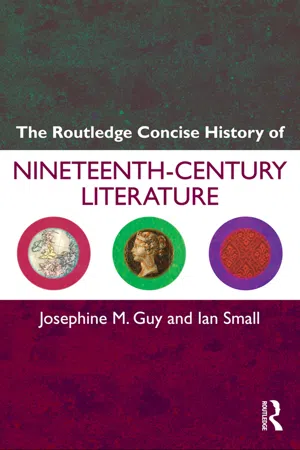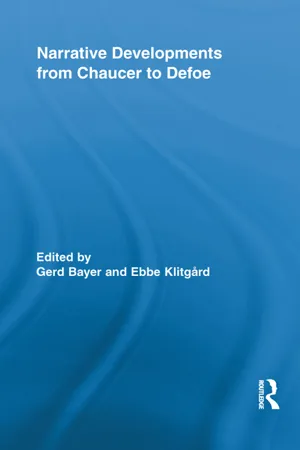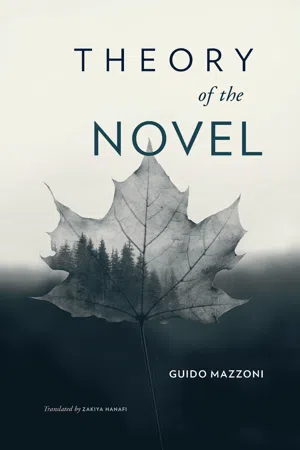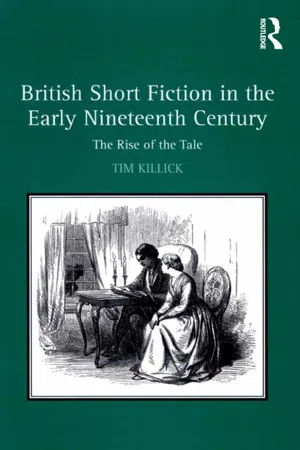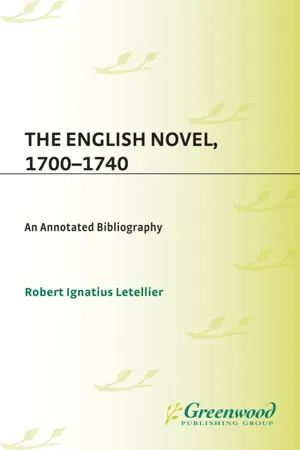Literature
The Early Novel
The early novel refers to the form of prose fiction that emerged in the 17th and 18th centuries, characterized by its focus on the individual and everyday life. It marked a shift from the epic and romance traditions, and is known for its realistic portrayal of characters and society. Key early novels include works by authors such as Daniel Defoe, Samuel Richardson, and Henry Fielding.
Written by Perlego with AI-assistance
Related key terms
1 of 5
5 Key excerpts on "The Early Novel"
- Josephine Guy, Ian Small(Authors)
- 2010(Publication Date)
- Routledge(Publisher)
5 Nineteenth-century literature and historyOverview
It will be clear, from the argument outlined in Chapter 2 , that an important feature of nineteenth-century literature is often assumed to be its qualities of representation, that is, the ways in which literary forms (fiction, poetry and drama) were explicitly used by nineteenth-century writers to engage with a variety of contemporary intellectual, social or political issues. A usual way of framing this engagement of nineteenth-century literature with social life is in terms of the relationship between a literary work and what is loosely called its historical ‘context’. Over the past three to four decades interest in the historical contexts of nineteenth-century literature has tended to draw attention to the political or ideological elements of literary works – to what some critics have called the ‘ideological work’ which they do. That said, there are several ways of defining context, as well as of understanding the relationship between it and a literary work. These differences in their turn have been influenced by a larger philosophical debate about the extent to which all knowledge of the past is relative.Proponents of relativism argue that the way we construct knowledge of the past is, in part, through literary tropes: in this argument the devices which we associate most commonly with literature – such as metaphor or certain kinds of narrative structures or plots – are also to be found in historical writing, particularly in the nineteenth century (White 1973). Moreover, because literary and historical narratives are constructed in similar ways, so the distinction between fiction and history will always run the risk of being blurred. If we accept that knowledge of the past was (and is) constructed in this manner, and if that process of construction inevitably involves elements of selection and evaluation, then it follows that knowledge of the past can never be objective.- eBook - ePub
- Gerd Bayer, Ebbe Klitgard(Authors)
- 2011(Publication Date)
- Taylor & Francis(Publisher)
9 It does so in showing how the early modern period builds on top of rather than is a reaction to the Middle Ages, an obvious point to a medievalist, but occasionally not to scholars who share vague notions of some dark and dim intermediate time before the rebirth or renaissance of the great classical period. Cooper traces a series of romance motifs such as magic, quest, pilgrimage, women on trial, etc., and she shows how popular romances repeat and twist these motifs in stories across centuries.NARRATIVE FORM IN THE EARLY MODERN AGE
In early studies on the history of the novel, the Elizabethan age is frequently presented as a period of rich experimentation and high achievement. However, critics like Walter Raleigh, author of a somewhat dated history of the novel first published in 1899, have also argued for the relative shortness of this bloom: “The end of the reign of Elizabeth marks at once the zenith of the English drama and the end of the first period of the English novel” (87).10In his critical survey of early modern discussions of narrative form in The Cambridge History of Literary Criticism , Paul Salzman stresses the importance of individual texts as inventors of particular prose traditions (giving special emphasis to Sidney’s Arcadia and to Lyly’s Euphues ), but also acknowledges the fact that in the sixteenth and seventeenth centuries, no critical debate about a genre in the sense of homogenous group of writings existed with reference to prose narratives since the novel as a genre is an invention of twentieth-century criticism (295). When it comes to narrative form, then, the Renaissance offers a richness of variation that deserves detailed attention, an approach that also marks Robert Maslen’s study of the formal innovations of Elizabethan prose and their tendency to make visible the various forms of deceit and duplicity that dominated the official system of power.11 - eBook - PDF
- Guido Mazzoni, Zakiya Hanafi(Authors)
- 2017(Publication Date)
- Harvard University Press(Publisher)
Hillhouse, The Waverley Novels and Their Critics (Minneapolis: University of Minnesota Press, 1936), 76. 81. Brown, Institutions of the English Novel , 176ff. 82. George Henry Lewes, “Criticism in Relation to Novels,” Fortnightly Review 3 (De-cember 15, 1865–February 1, 1866): 352. 83. Stang, The Theory of the Novel in England, 3–46. T H E B I R T H O F T H E M O D E R N N O V E L 213 If we wanted to identify a threshold in this slow transformation that took place in different layers, lasting almost a century, we would have to choose the year 1800. The date serves as a frontier both because it marks the midpoint between the time in which some avant-garde writers, such as Rousseau and Goethe, began to devote themselves to the novel, and the moment in which the rise of the genre became a fait accompli; also because it indicates the symbolic boundary starting from which the new form displayed its revolutionary character. We have seen that the early modern history of the novel is the history of a dialectic: some of its elements con-flicted with classicism and Christian aesthetic Platonism, while others were completely permeated with them. For a long time, writers and critics sought legitimacy by accentuating the continuous aspect. Friedrich Schlegel was the first to openly insist on the breach that the novel introduced into Euro-pean literary history. Many writers of his generation followed suit. Born between two paradigms, Madame de Staël, Friedrich Schlegel, Novalis, Scott, and Foscolo clearly perceived this historic threshold. The literature that continued to operate within the structures of sense derived from clas-sicist and Platonic sources possessed a ritual system of forms and content; the new literature entered into the domain of particularity and proliferated without rules. - eBook - ePub
British Short Fiction in the Early Nineteenth Century
The Rise of the Tale
- Tim Killick(Author)
- 2016(Publication Date)
- Routledge(Publisher)
In spite of the importance of the American short story boom and its Victorian heirs, my contention is that the focus on the mid-to-late century inevitably marginalises a large part of the history of the genre. Such an attitude is arguably a result of reading backwards—of criticising the short fiction of the earlier part of the century in light of both the Victorian short story and the theorisation of the genre that took place after the 1840s. The short fiction produced in Britain during the early nineteenth century deserves more critical attention than it has so far received, and the practice of mapping generic change should not simply be a case of tracing significant influences. The process of historical analysis should encompass not only the trends and qualities that came to define the later stages of a genre, but should also give attention to innovative modes and sub-genres that failed to germinate and remain peculiar to their own era. The rush to point to the first, best, and most significant can lead to quick assumptions and easy dismissals of texts and writers whose contributions, though quieter than others’, were examples of widespread practice at the time of writing and which are still immensely valuable to critics when looking back at the literature of an earlier era.The assumption of a relative lack of literary merit is one way in which modern criticism has limited readings of early-nineteenth-century short fiction, but it is not the only way. A second somewhat pernicious critical supposition involves locating short fiction within the rather nebulous notion of an archetypal Romantic text. By situating early-nineteenth-century short fiction in comparison to an idealised external mode an unrealisable opposition is set up. The fiction of the early part of the century seldom conforms to the aesthetic values and concepts of art that literary critics have attributed to the poets and philosophers of the Romantic period. In spite of this, some studies of short fiction have sought to locate its early-nineteenth-century incarnation within a poetic Romantic tradition. Charles May, one of the most important and influential modern short story theorists, conflates the aesthetic concerns of Romantic-era short fiction with those of poetry, and attempts to imbue the genre with a peculiarly Wordsworthian sensibility and a history similar to that of the lyric poem—in effect giving short fiction a similar ideology to that expressed by Wordsworth in his 1802 Preface to Lyrical Ballads - eBook - PDF
The English Novel, 1700-1740
An Annotated Bibliography
- Robert Letellier(Author)
- 2003(Publication Date)
- Greenwood(Publisher)
London alone had 17 newspapers, 6 dailies, 5 or 6 thrice-weeklies. By 1740 a more pointedly political note was developing in the newspapers. It was no longer an experiment or miscellany, but a vehicle of information and discourse about the pressing public events of the time and place. It would remain like this for the rest of the century. Looks at 1) English backgrounds; 2) America: narrative; 3) America: structures and transitions. Appendix (267-68). Notes (269- 318). Index (319-30). 324 CLARK, Edith L. "The negro in fiction: a historical and critical sketch." Unpub. master's thesis, Univ. of Texas, 1902. Abstract not available. 325 CLAYTON, Jay. Romantic vision and the novel. Cambridge; New York; Melbourne: Cambridge UP, 1987; pp. x, 249. Introd. "Transcendence of the Novel" (1-26) provides important background for the emergence of the novel. Visionary power is antithetical to realistic representation. Transcendence is violent, and the fate of those who embody the absolute, like love, goodness and power, is severe. 326 CLEMENTS, Frances. "The rights of women in the eighteenth-century novel". EE 4:314 (1973): 63-70. Considers a selection of novels from the years immediately following the publication of Pamela. These years represent the first flowering of the English realistic novel, and show that a concern for women's rights is central, and that these novels make the same demands for women which Mary Wollstonecraft was to make in 1792. The novelists' involvement with the problems of women is clearfromthe titles of their works; they are also alert to the heroine's problems as a victim of 18c social injustice. 327 CLIFFORD, James Lowry (ed.). Man versus society in eighteenth-century The English Novel, 1700-1740 Britain. Six points of view. London: Longman, 1956; pp. 175. Collection of 6 essays in history, economics, religion,fineart, music and literature, examining aspects of the life and times.
Index pages curate the most relevant extracts from our library of academic textbooks. They’ve been created using an in-house natural language model (NLM), each adding context and meaning to key research topics.
